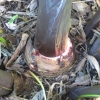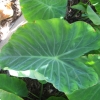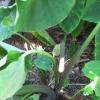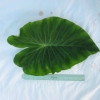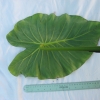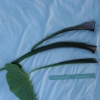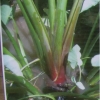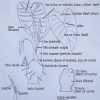Use As Food
Good for poi. The leaves are good for lū‘au.
Distribution
Little-known variety, found only occasionally around Hilo and in Puna, Hawai‘i, under māla (upland) culture.
General Characteristics
Medium in height, moderately spreading, maturing within 8 to 12 months, producing from 5 to 10 oha; similar to ‘Apowale except that the flecking and color of kōhina (base) are lighter and the Hā (Petiole) are reddish at point of juncture with the Lau or lū‘au (Leaf blade).
Ha (Petiole)
70 to 90 cm. long, dark green with dark purplish tinge on lower portion, flecked near kōhina (base), light reddish-brown at the top (apex), reddish-brown at the lihi (stem edge), a light pink ring at the kōhina (base).
Lau or Lu'au(Leaf Blade)
45 to 55 cm, long, 30 to 40 cm. wide, 35 to 45 cm. from tip to base of sinus (māwae), arrow head shaped, somewhat concave (curve inward), dark green; margins slightly wave-like (undulate); piko light reddish-purple; round leaf section (lobes) acute with narrow lihi māhae (sinus).
'I'o kalo (Corm)
Flesh white with yellowish fibers; skin light to dark purple, the leaf scars dark purple.
Pua (Flower)
Hā (peduncle) dark green with brownish flecking on lower part; flower cover (spathe) 22 to 26 cm. long, the lower tubular portion 3 to 3.5 cm, long, dark green with purple at kōhina (base), the upper portion yellow; spadix (spike of flower) about 10 cm. long, the sterile appendage (tip of flower's spike) 8 to 9 mm. long.
Remarks
Growers state that this variety can be held over in the fields for a considerable period after maturity without serious loss from soft rot.

